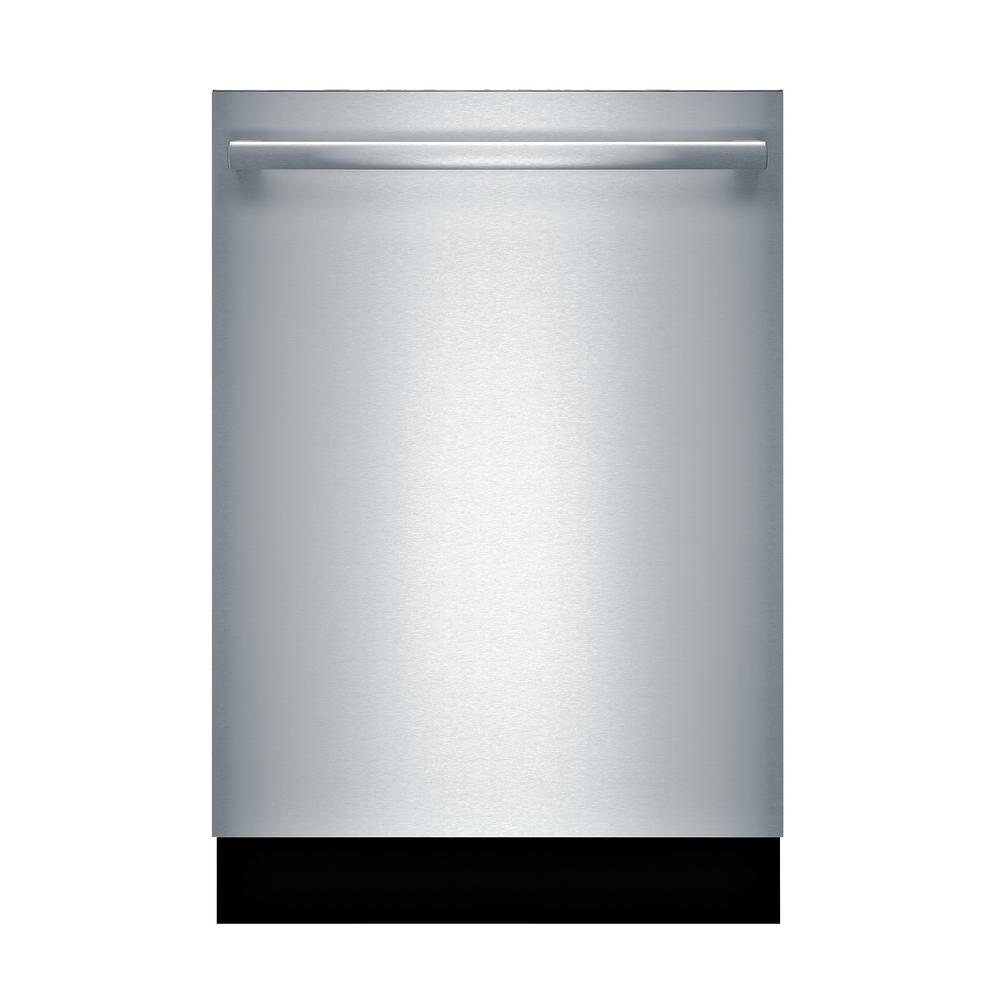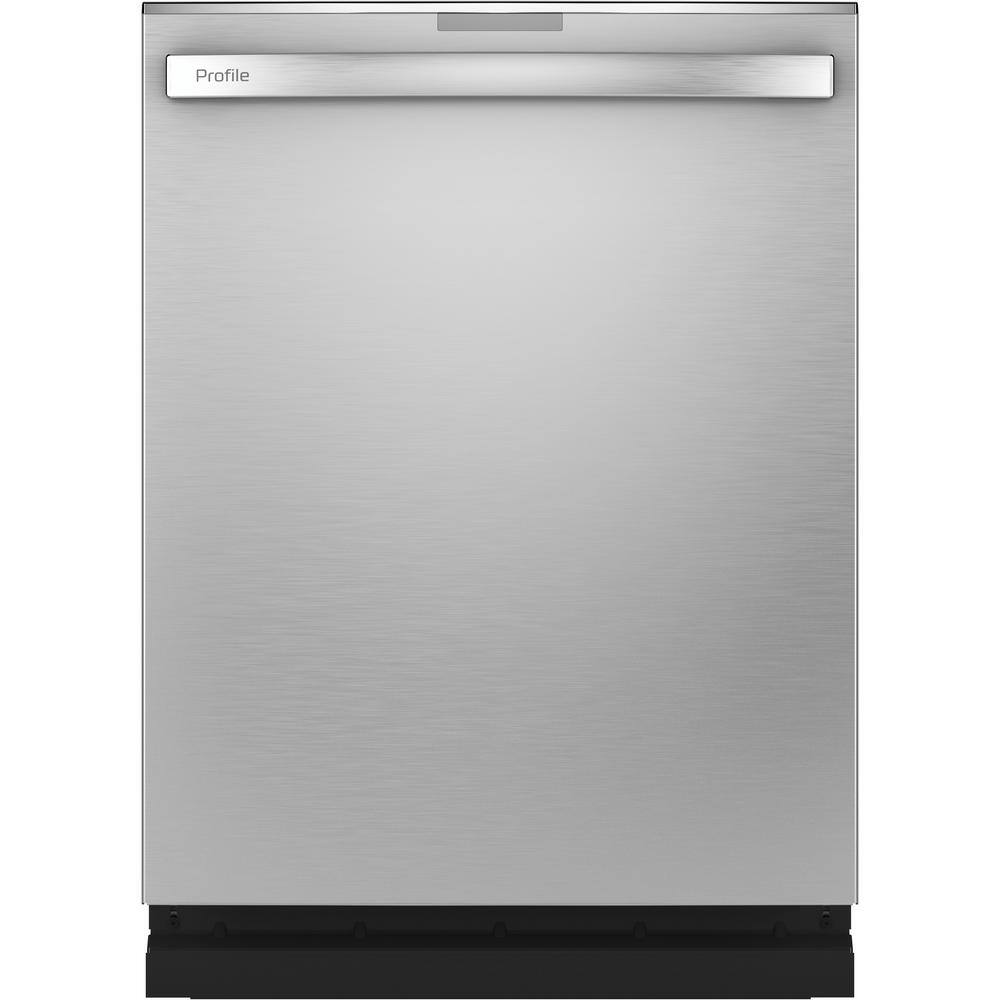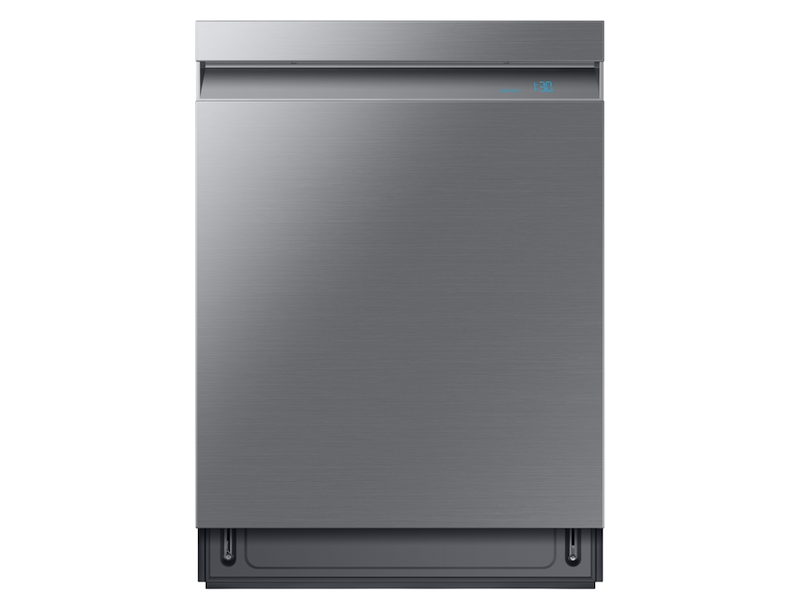Bosch 800 Series 24 in. Stainless Steel Top Control Tall Tub Dishwasher with Stainless Steel Tub, Crystal Dry, 42dBA
Patented CrystalDry technology gives dishes the ultimate dry. Flexible 3rd rack for silverware and cooking utensils. InfoLight shines on the floor so you know if the cycle is running.
The ultimate clean. The ultimate dry, even plastics. The Bosch 800 Series dishwasher delivers a sparkling clean and dry with advanced PrecisionWash technology and patented CrystalDry technology. With PrecisionWash, intelligent sensors continually scan and check the progress of dishes throughout the cycle, and powerful spray arms target every item of every load, for the ultimate clean. Patented CrystalDry technology transforms moisture into heat up to 176F for the ultimate dry, even for plastics.
- 3 Prong Power Chord Included. Junction box for hardwire application sold separately (Model # SMZPCJB1UC)
- Sanitize Option reduces 99.9% of bacteria with a hot-wash rinse for sparkling clean and sanitized dishes
- Sanitize your dishes: The Sanitize feature is available only in the Heavy, Auto, Normal and Half Load cycles. Select one of these cycles, press the “Sanitize Option” button and then press Start to activate the Sanitation features. The sanitize LED will light when sanitation requirements are met. The sanitation option eliminates bacteria and may enhances drying results.
- Hidden integrated electronic controls maintain a clean exterior and InfoLight shines a red beam on the floor to indicate when the dishwasher is running
- Extremely quiet operation (42 dBA)- incorporates 18 unique sound-reducing technologies such as multiple insulation layers, grindless food filtration, and a sound absorbing base
- Large interior provides loading flexibility necessary to easily accommodate 16 place settings, and the Flexible 3rd rack adds space for cooking utensils and ramekins
- Bosch’s advanced PrecisionWash system has intelligent sensors that continually scan and check the progress of dishes throughout the cycle, and powerful spray arms target every item of every load, for the ultimate clean
- Every Bosch dishwasher is ENERGY STAR qualified and meets or exceeds federal guidelines, for year-round energy savings
- Full stainless steel tub is sleek, durable and long-lasting
- Precisely engineered detergent tray holds detergent tabs in place for a dedicated spray jet to directly dissolve them, preventing buildup for a deeper clean
- Rackmatic adjustable upper rack easily adjusts to 9 different positions, to allow taller items like stemware to fit in the middle rack while leaving room for bulky items below. The flip tines make loading wide bowls easy and ball bearing wheels provide a smooth glide
- FlexSpace Tines on the lower rack- fold down every other tine in one simple step to make room for larger, bulkier items while optimizing the rack space
- Flexible 3rd Rack with fold down sides adds 30% more loading area compared to a Bosch dishwasher with 2 racks, perfect for utensils and ramekins. Also includes a lower rack silverware basket.
- Precisely engineered and laser cut, the precision spray arms aim water directly at dishes for the ultimate clean while minimizing noise
- Half Load Option allows you to load half of the normal dishes anywhere in the dishwasher to reduce water usage without sacrificing wash performance
- A dishwasher water connection kit is required for installation
- Energy Star
Additional information
| Cut-Out Depth x Height x Width (in.) | 24 x 33.88 x 23.63 |
|---|---|
| Depth - Door Shut (with Handle) (in.) | 23.75 |
| Depth - Door Shut (without Handle) (in.) | 23.75 |
| Depth With Door Open 90 Degrees (In) | 48.4375 |
| Dishwasher Size (In.) | 24 |
| Height - Maximum (in) | 35.0625 |
| Height - Minimum (in) | 33.875 |
| Product Depth x Height x Width (in.) | 23.75 x 33.875 x 23.563 |
| Certifications and Listings | CSA Listed,Energy Star,NSF Certified,UL Listed |
| Manufacturer Warranty | 1 Year Limited |
24 may refer to:
- 24 (number), the natural number following 23 and preceding 25
- one of the years 24 BC, AD 24, 1924, 2024
Year 800 (DCCC) was a leap year starting on Wednesday (link will display the full calendar) of the Julian calendar, the 800th year of the Common Era (CE) and Anno Domini (AD) designations, the 800th year of the 1st millennium, the 100th and last year of the 8th century, and the 1st year of the 800s decade. It was around this time that the Anno Domini calendar era became the prevalent method in Europe for naming years, so from this time on, the years began to be known as 800 and onwards.
A crystal or crystalline solid is a solid material whose constituents (such as atoms, molecules, or ions) are arranged in a highly ordered microscopic structure, forming a crystal lattice that extends in all directions. In addition, macroscopic single crystals are usually identifiable by their geometrical shape, consisting of flat faces with specific, characteristic orientations. The scientific study of crystals and crystal formation is known as crystallography. The process of crystal formation via mechanisms of crystal growth is called crystallization or solidification.
The word crystal derives from the Ancient Greek word κρύσταλλος (krustallos), meaning both "ice" and "rock crystal", from κρύος (kruos), "icy cold, frost".
Examples of large crystals include snowflakes, diamonds, and table salt. Most inorganic solids are not crystals but polycrystals, i.e. many microscopic crystals fused together into a single solid. Polycrystals include most metals, rocks, ceramics, and ice. A third category of solids is amorphous solids, where the atoms have no periodic structure whatsoever. Examples of amorphous solids include glass, wax, and many plastics.
Despite the name, lead crystal, crystal glass, and related products are not crystals, but rather types of glass, i.e. amorphous solids.
Crystals, or crystalline solids, are often used in pseudoscientific practices such as crystal therapy, and, along with gemstones, are sometimes associated with spellwork in Wiccan beliefs and related religious movements.
A dishwasher is a machine that is used to clean dishware, cookware, and cutlery automatically. Unlike manual dishwashing, which relies on physical scrubbing to remove soiling, the mechanical dishwasher cleans by spraying hot water, typically between 45 and 75 °C (110 and 170 °F), at the dishes, with lower temperatures of water used for delicate items.
A mix of water and dishwasher detergent is pumped to one or more rotating sprayers, cleaning the dishes with the cleaning mixture. The mixture is recirculated to save water and energy. Often there is a pre-rinse, which may or may not include detergent, and the water is then drained. This is followed by the main wash with fresh water and detergent. Once the wash is finished, the water is drained; more hot water enters the tub by means of an electromechanical solenoid valve, and the rinse cycle(s) begin. After the rinse process finishes, the water is drained again and the dishes are dried using one of several drying methods. Typically a rinse-aid, a chemical to reduce the surface tension of the water, is used to reduce water spots from hard water or other reasons.
In addition to domestic units, industrial dishwashers are available for use in commercial establishments such as hotels and restaurants, where many dishes must be cleaned. Washing is conducted with temperatures of 65–71 °C (149–160 °F) and sanitation is achieved by either the use of a booster heater that will provide an 82 °C (180 °F) "final rinse" temperature or through the use of a chemical sanitizer.
Dry or dryness most often refers to:
- Lack of rainfall, which may refer to
- Arid regions
- Drought
- Dry or dry area, relating to legal prohibition of selling, serving, or imbibing alcoholic beverages
- Dry humor, deadpan
- Dryness (medical)
- Dryness (taste), the lack of sugar in a drink, especially an alcoholic one
- Dry direct sound without reverberation
Dry or DRY may also refer to:
Stainless may refer to:
- Cleanliness, or the quality of being clean
- Stainless steel, a corrosion-resistant metal alloy
- Stainless Games, a British video game developer
- Stainless Broadcasting Company, a TV broadcaster based in Michigan, US
- Stainless Banner, the second national flag of the Confederate States of America
Steel is an alloy of iron and carbon with improved strength and fracture resistance compared to other forms of iron. Because of its high tensile strength and low cost, steel is one of the most commonly manufactured materials in the world. Steel is used in buildings, as concrete reinforcing rods, in bridges, infrastructure, tools, ships, trains, cars, bicycles, machines, electrical appliances, furniture, and weapons.
Iron is always the main element in steel, but many other elements may be present or added. Stainless steels, which are resistant to corrosion and oxidation, typically need an additional 11% chromium.
Iron is the base metal of steel. Depending on the temperature, it can take two crystalline forms (allotropic forms): body-centred cubic and face-centred cubic. The interaction of the allotropes of iron with the alloying elements, primarily carbon, gives steel and cast iron their range of unique properties. In pure iron, the crystal structure has relatively little resistance to the iron atoms slipping past one another, and so pure iron is quite ductile, or soft and easily formed. In steel, small amounts of carbon, other elements, and inclusions within the iron act as hardening agents that prevent the movement of dislocations.
The carbon in typical steel alloys may contribute up to 2.14% of its weight. Varying the amount of carbon and many other alloying elements, as well as controlling their chemical and physical makeup in the final steel (either as solute elements, or as precipitated phases), impedes the movement of the dislocations that make pure iron ductile, and thus controls and enhances its qualities. These qualities include the hardness, quenching behaviour, need for annealing, tempering behaviour, yield strength, and tensile strength of the resulting steel. The increase in steel's strength compared to pure iron is possible only by reducing iron's ductility.
Steel was produced in bloomery furnaces for thousands of years, but its large-scale, industrial use began only after more efficient production methods were devised in the 17th century, with the introduction of the blast furnace and production of crucible steel. This was followed by the Bessemer process in England in the mid-19th century, and then by the open-hearth furnace. With the invention of the Bessemer process, a new era of mass-produced steel began. Mild steel replaced wrought iron. The German states were the major steel producers in Europe in the 19th century. American steel production was centred in Pittsburgh, Bethlehem, Pennsylvania, and Cleveland until the late 20th century. Currently, world steel production is centered in China, which produced 54% of the world's steel in 2023.
Further refinements in the process, such as basic oxygen steelmaking (BOS), largely replaced earlier methods by further lowering the cost of production and increasing the quality of the final product. Today more than 1.6 billion tons of steel is produced annually. Modern steel is generally identified by various grades defined by assorted standards organizations. The modern steel industry is one of the largest manufacturing industries in the world, but also one of the most energy and greenhouse gas emission intense industries, contributing 8% of global emissions. However, steel is also very reusable: it is one of the world's most-recycled materials, with a recycling rate of over 60% globally.
Tall commonly refers to:
- Tall, a degree of height
- Tall, a degree of human height
Tall may also refer to:
Top most commonly refers to:
- Top, a basic term of orientation, distinguished from bottom, front, back, and sides
- Spinning top, a ubiquitous traditional toy
- Top (clothing), clothing designed to be worn over the torso
- Mountain top, a mountain peak located at some distance from the nearest point of higher elevation
Top may also refer to:
Tub may refer to:
- A tub (container):
- a round or oblong container with or without a lid:
- a plant pot
- a shallow, plastic or paper container, typically with a lid or closure
- Tub (unit), a former quantity for sale or butter or cheese
- a round or oblong container with or without a lid:
- A bathtub, a plumbing fixture for bathing
- Hot tub, a large bath or small pool designed to comfortably hold multiple persons
- Quarry tub, a type of railway or tramway wagon
- Slack tub, in blacksmithing, a quench
- Tub boat, an unpowered cargo boat used on early canals
- Twin tub, a type of washing machine
- Tub file, in computing, an early, primitive random access memory technology.
- Tub Welch, a baseball player.
TUB may refer to:
- TUB (gene)
- Citroën TUB, a light van
- Technische Universität Berlin (Germany)
- Transports Urbains du Beauvaisis, local public transport operator in northern France
- Tubuai – Mataura Airport (IATA airport code)
TUBS or Tubs may refer to:
- Time unit box system, a system for notating events that happen over a time period.
- Tokai University Boarding School in Denmark
- Ryan Tubridy, Irish television and radio presenter.
With or WITH may refer to:
- With, a preposition in English
- Carl Johannes With (1877–1923), Danish doctor and arachnologist
- With (character), a character in D. N. Angel
- With (novel), a novel by Donald Harrington
- With (album), a 2014 album by TVXQ
- With (EP), a 2021 EP by Nam Woo-hyun






by Dee
[This review was collected as part of a promotion.] If you want a quiet dishwasher this is your machine. Absolutely love top silverware tier. Makes it so easy to put up silverware. Really enjoy ability to move or even take out bottom silverware drawer for room for large pans. Dishes come out sparkling. Best buy I’ve made in a long while.
by Montana
This is my second Bosch since 2000. I loved the first dishwasher, but eventually the 3 buttons on the front wore out. If this lasts 20 plus years, I will be happy.
by Ruth
The Bosch 800 series dishwasher is awesome. It is super quiet, so much so that Bosch had to put an indicator light on it so one can tell when it’s running.
by Robert
Very hard to operate. No real user manual. Still do not know how to work it right.
by Rebecca
big and beautiful! much better cleaning than any other.
by Becky
Excellent dishwasher!
by Connie
Overall met all expectations, quiet performance, ease/flexibility of installation. Overall quality unit and happy so far. Did take a few minutes to work through the controls.
by Ross
[This review was collected as part of a promotion.] This dishwasher is so quiet it needs a light to tell you when it’s running. Dishes come out clean and dry every time. It may cost a bit more to purchase but it’s well worth it. Very high quality.